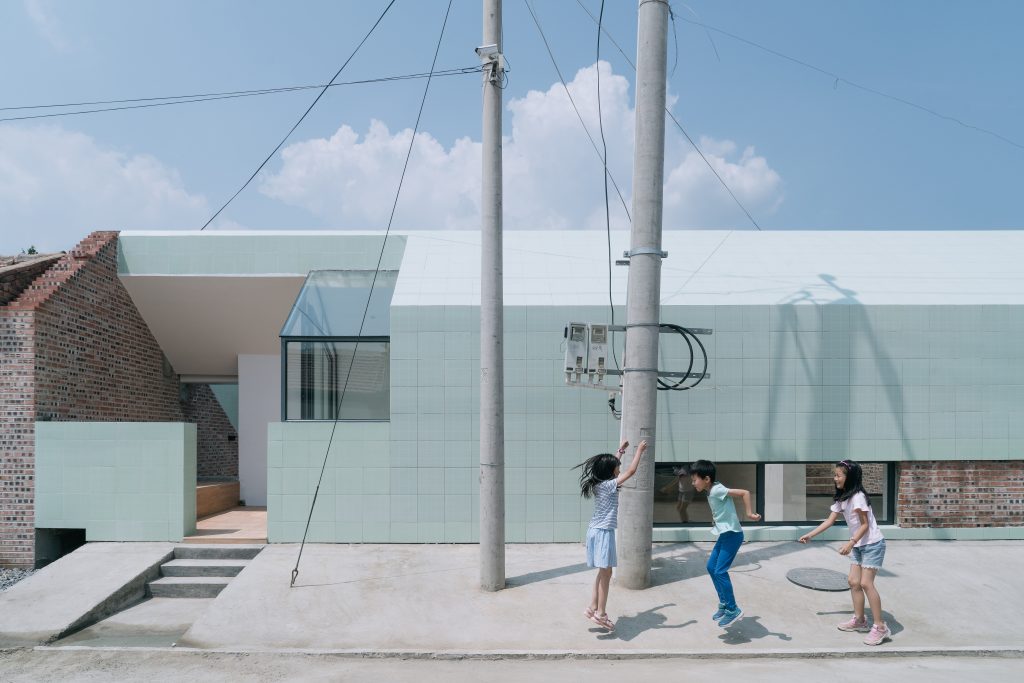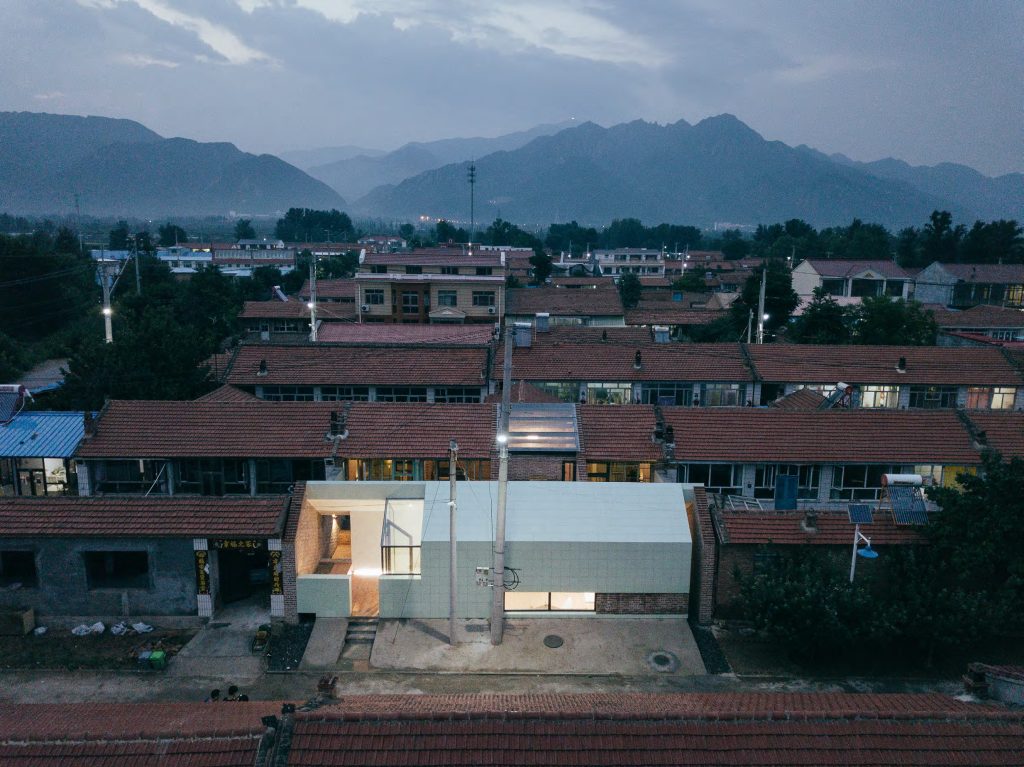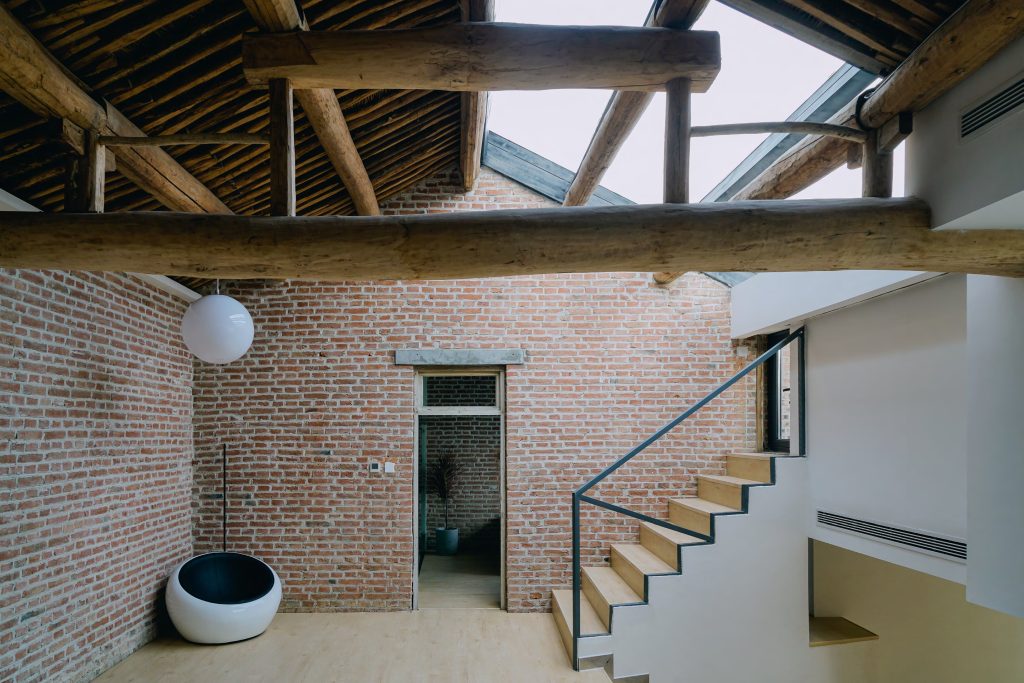

“互舍”与演变

一:追忆 Recall
后黑龙庙村位于北京延庆海坨山下,夏日青翠的高粱地,和冬季冰封的水漫树林是其典型景观。这里充满了北方乡村特有的宁静、舒朗和萧索——蝉鸣,朝雾,红砖房和深秋醉蓝的天空。抛却了古典绘画的诗意想象,像极了当代写实主义油画充满张力的日常即景。
Houheilongmiao Village is located at the bottom of Haiying Mountain in Yanqing, Beijing, with green sorghum fields in summer and frozen water-filled woods in winter. It is full of the tranquility, soothing and bleak which are unique to the northern countryside. Here are cicadas, fog, red brick houses and the blue sky in late autumn. Abandoning the poetic imagination of classical painting, it is like a daily scene that is full of tension in contemporary realist oil oil painting.
二:关系 Relationship
历史的结束便是记忆的开始”(阿尔多·罗西),这处80年代兴建的房屋起初被用于婚房。30年多年后的今天,这里将会迎来新的“家庭”——朋友或是新人们;时光穿越,相逢恨晚;家庭的“温度”却始终不变。
“The end of history is the beginning of memory” (Aldo Rossi). This house built in the 1980s was originally used as a wedding room. Today, more than 30 years later, here will usher in a new “family”-friends or new people; time travels, meets with nostalgia; the family “temperature” is always the same.


Mutual reciprocity in the ‘Reciprocal House’ is reflected in three levels: The first is the interaction of the new and old houses. The village’s traditional sloping roof form and intimate dimensions have become invisible memories, which continue in the design. The intersecting positions of the two north and south rooms form a “mutual” occlusal space. In order to enlarge the original experiencing interior space experience, the new house on the south side was dug down, and people entered the north room through the rising stairs, which seemed redundant. The “design action” makes the space come alive as the height changes, and the cave-like living experience is born.
互舍的“互”体现在三个层面:
首先是新旧房屋的造型“交互”,村庄的传统坡屋顶形式和让人感到舒适亲切的尺度成为了隐形的记忆,在设计中延续。南北两房交错的位置形成“互”字般的咬合空间,为了使原本逼仄的室内空间体验感放大,南侧的新屋被下挖,人们再通过上升的楼梯进入北房,这样看似多余的“设计动作”让空间因高差变化而变得生动,洞穴般的居住体验也由此而生。


第三层“交互”是室内隐藏的一条闭合流线,“圆形”路径似乎也隐喻着“园”。起于入户的玄关庭院,接着看到现代感的南房,继而通过“山谷”步入充满怀旧气氛的北房,通过小洞口爬上露台,从大阶梯上再步入庭院和卧房,完成 “山居巡游”。这种伴随“现代性”而生的运动感并非新生事物,100年前阿道夫·路斯的 “螺旋空间”(‘Raumplan’)住宅即给出了答案。今天,在室内欢快奔跑的孩子和时时来访的小猫似乎对其仍然兴趣盎然。
The third level of “interaction” is a closed streamline hidden in the interior, and the “circular” path also seems to be a metaphor for “garden”. It starts from the entrance courtyard, and then sees the modern south house. Then it enters the nostalgic north house through the “valley”, climbs to the terrace through the small hole, and then enters the courtyard and bedroom from the large step accomplishing the “Mountain House Wandering”. This sense of movement that accompanies “modernity” is not new, and Adolf Loos ‘s “Raumplan” house gave the answer 100 years ago.. Today, children who run happily indoors and kittens who visit from time to time still seem to be full of excitement.
关于材质的“交互”的表达,我们希望能够延续红砖绿窗的记忆。瓷砖这种华北乡村常见的建材表达了村民清洁卫生的朴素需求,我们既不想为了“建构”欲望而刻意暴露真实建筑材质,也并非要“民粹”般地歌颂流行乡间的大白瓷砖,“天青色”的瓷砖被选作南房的表皮, 瓷砖绿和砖红形成“大俗”撞色,却充满了火热的生活质感。
Regarding the expression of “interaction” of materials, we hope to continue the memory of the red brick and green window. Tiles, a common building material in the North China countryside, expressing the villagers ’simple needs for cleanliness. We don’t want to deliberately expose the real building materials in order to ‘construct’ the desire, nor do we want to sing the populous big white tiles like populist, The ceramic tile was selected as the skin of the south house, and the tile green and brick red formed a “vulgar” contrasting color, but filled with the fiery texture of life.


项目名称:互舍
建筑地点:北京延庆
竣工时间:2019年
建筑面积:220平米
建筑设计:王冲
施工图与软装设计:王冲、金泰霖
摄影:朱雨蒙
三:媒介 Media
在北京,雨水让人既爱又恨,暴雨的六月和干冷的冬季周而复始。从天而降,涓涓细流,归于土壤,这种雨水循环在“互舍”变得可观。始于屋顶的汇聚,经过 “沟渠”从中部露台蜿蜒汇至庭院,继而沿着碎石路径引至于道路明沟,这些过程从庭园和室内被居住者耳闻目视,在雨天则形成生动的景观体验。而在旱季,碎石铺地则带来“枯山水”的想象。
卡尔维诺说:“你跑了那么远的路,只是为了摆脱怀旧的重负!”,当民宿和旅行成为丰裕社会的生活形态,我们希望居住者不仅看到华北乡村的记忆拼图,还能轻松地看看明天,新旧互为因借。In Beijing, the rain makes people love and hate it. The heavy rains of June and the dry winter cycle start and end. Falling from the sky, trickling down to the soil, this kind of rainwater cycle becomes considerable in “interchange”. It starts from the convergence of the roof, winding from the central terrace to the courtyard through the “ditch”, and then leading to the open channel of the road along the gravel path. These processes are seen and heard from the garden and indoor occupants, and form a vivid landscape in the rain experience. In the dry season, gravel paving brings the imagination of ” Karesansui”.
Italo Calvino said, “You ran so far, just to get rid of the burden of nostalgia!” When homestays and travel become a life form of a rich society in China, we hope that visitor will not only see the memory puzzles of the North China countryside, but also easily Look at tomorrow, the old and the new are borrowing each other.
